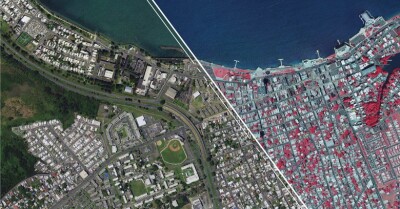Image source: DPR Review
When you’re implementing a new data capture technology, hardware matters less than people and IT systems
To see three of my initial impressions of the Commercial UAV Expo in Las Vegas, please see a note that I penned on the second day of the event. The eagle-eyed will notice a common theme that I’ve observed at this event and other events during this conference season: “education, education, education.” It is encouraging to see the industry taking time to engage with the market in a manner that goes beyond handing out specification sheets. Within the UAV space especially, it is reassuring to observe a growth in the number of companies looking to advise end users on processes and legislative matters.
In my opinion, the presentation from UAV Expo that stood out the most was given by Scott Widmann from DPR Construction, on reality capture from UAVs. Not only did his presentation walk the audience through a selection of defined case studies to show how UAV technology is being implemented at DPR, but he also had one of the most important messages for anyone looking to implement new data capture technology in general.
“A UAV implementation strategy is more about addressing implications on back office IT and people systems.”
Scott was making the point that the type of UAV and sensors mounted upon it were almost irrelevant for the successful implementation of a UAV solution at DPR. Instead, success is measured by the extent to which the wider team accepts and comes to rely upon the UAV’s data, together with the extent to which IT partners are working together to ensure that this influx of new data is being stored, backed-up, managed and served.
For example, when the site Superintendent is asking for the daily UAV images, and they can be found easily on the enterprise systems, then you know that your new data capture technology is really providing value to your organization. Scott encourages that we use the types of data supplied by UAVs in this way, to empower teams and foster collaboration.
This goes for any data-capture technology
Watching Scott’s presentation hit home the limiting factors in the application of any new 3D-imaging system in an organization. Typically, the limiting factor will not be the resolution of a camera, the flight time of a UAV, or the specified accuracy of a laser scanner. Instead, initial success will be a function of how easy it will be for users and stakeholders to load and view that data on their desktop or smartphone.
Ultimately though, success in the long term will be dictated by how swift and easy it is for these new datasets to be logged, organized on a server, and made available to the next user—without a user needing to think about issues such as differences in data formats, data conversion, and upload/download speeds.
The lesson is that the following kind of experience needs to be ubiquitous and business-as-usual: A site Superintendent views a panoramic camera image on his or her tablet with ease, and that image is in the correct location on the site plan and associated with the pertinent time-stamp and asset information in the construction management system.
At SPAR this year, I blogged about the downward pressure on the costs of acquisition systems used for updating our 3D models and data repositories. So much data is now being collected that we need to make serious moves to organize what we collect, and make it available to people who are non-3D-Imaging-specialists but are domain-expert users. We also need to make it available in near real time.
To apply another acronym in our industry, perhaps we now need to think about our 3D Imaging solutions being SMART (Social, Mobile, Available and (near) Real Time)?
One comment made to me at Intergeo last month was that ‘if this year was about the UAV, perhaps next year will be about the software.’ As I look into 2016, I am keeping an eye on any announcements from those who provide our software infrastructures, on solutions that enable the use of the amazing new data collection systems that we have at our disposal – in a manner that helps us not have to think about it…






